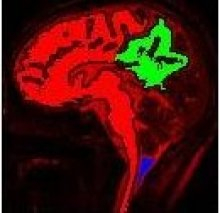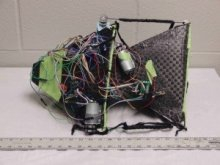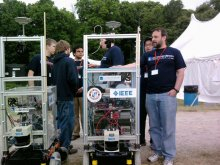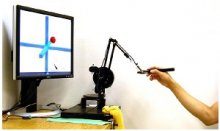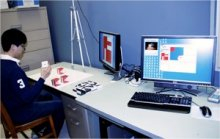Intelligence
A key research goal of the institute is to enable intelligent sensing and behavior in robotic systems. This goal encompasses creating robots that have accurate perception in a dynamic, complex environment; can reason efficiently with abstract states; and perform intricate actions in changing and uncertain environments. Intelligent robots and systems must also have the ability to adapt to novel tasks and scenarios and have the ability to learn from experience. In order to prepare students to do research on these topics, we offer an introductory undergraduate course on artificial intelligence as well as graduate level courses on probabilistic graphical models, machine learning, computer vision, and sequential decision making. The graduate level courses involve substantial projects that allow the students to apply the techniques they learn to solve practical problems.
Manufacturing Robots
Since the IRI is located in one of the major Rust Belt cities, a focus on manufacturing was inevitable. Though a great deal of manufacturing work was outsourced over the past few decades, it is beginning to return to the region. Cutting-edge robotics technology can help bring even more of that work to the region, increase the efficiency of manufacturing systems, and improve the quality of finished products. In addition to focusing on the classic manufacturing robotic systems like automation, the IRI is also thinking outside the box and coming up with to improve productivity through the use of assistive robots like ABBY that can bring parts and tools to workers to allow them to focus on the task at hand. Thanks to innovative work in this research theme, Cleveland is poised to become a manufacturing leader once again, this time for the 21st century.
Biorobotics
In one of the many areas for collaboration between departments, biorobotics—or biologically inspired robots—seek to develop robots that are derived from biological systems. Movement is a particular focus of biorobotics, as animals and insects have developed complex, adaptive, and flexible movement patterns that are surprisingly difficult to replicate mechanically. Some of the robots designed under this theme are the SeaDog is designed for marine and beach exploration through mimicing the movements of lobsters and cockroaches, and the TetraSpine which is modeled after the human spine and was built to be used for travel over various ground surfaces. The TetraSpine is being developed in conjunction with the NASA Ames Research Center and may one day be used for exploration of extraterrestrial surfaces as well. Mapping the movements of biological creatures has also lead to a focus on the neurological systems behind that movement. The combination of the two is being used to develop ground-breaking robots that can assist people with disabilities. Biorobotics has a laboratory at the IRI and courses devoted to the topic.
Mobile Robotics
Mobile robotics works to develop robots that are capable of moving dynamically and autonomously through any and all environments. The applications of these robots are endless, covering endeavors like exploration as well as serving as support systems for the disabled. There are also endless opportunities for collaboration with the other research themes (intelligence, assistive and manufacturing robotics), as well as with other departments across the university. This is particularly true for the School of Medicine and disciplines such as occupational and physical therapy as current work on mobile robotics at CWRU is focused on wheel-chair based systems. These robots have competed in several Intelligent Ground Vehicle Competitions (IGVC). More information about all the robots, the lab, and the research theme can be found on the Mobile Robotics Lab website. There are also courses offered specifically on this topic for both undergraduates as well as graduates.
Medical Robotics
Not only is Cleveland one of the largest health-care communities in the world, the medical field is rapidly expanding and the demand for technological innovations is enormous. More importantly, this is a field where robotics has the potential to do enormous good. The IRI, and particularly the Medical Robotics and Computer Integrated Surgery (MeRCIS) Lab have a particular focus on robotic surgical systems, specifically on building the next generation of robotic tele-surgical (or remote) systems. These robots will be capable of such precise movement that physicians will be able to perform surgical procedures that would not otherwise be possible (such as beating heart surgery). Under this research theme the IRI is also working to create robotic systems for image-guided interventions, such as MRI guided robotic catheters, as well as improving the general capability and intelligence of robotic surgical systems with the goal of producing robotic surgical assistants capable of autonomously performing tasks such as suturing. Another focus under this research theme is haptics where researches work toward a greater understanding human sensory-motor performance in manipulation tasks. This greater understanding of how people move, interact with mechanical and robotic systems, and their accompanying neurological process will allow researchers to create enhanced robotic surgical systems and develop better surgical training simulators. These projects are just beginning to scratch the surface of all that robotics can offer the medical field.
Assistive Robotics
There are no limits to the ways that robotics can be used to assist humans from offering physical and mechanical support to training to even providing companionship. Research and projects under this theme span an incredible range. The wheel-chair based robots in development by the Mobile Robotics Lab have enormous potential in improving wheel chair technology; a number of the robots in development at the MeRCIS Lab are intended to assist in surgical procedures; and the Distributed Intelligence and Robotics Lab has a number of projects that can be used in assessing neurocognitive function (TaG-Games) or monitoring health data for compromised patients (Philos). Also, in an area of rapidly growing innovation for robotics, Philos can provide emotional support for those patients. Developing robotics that can assist and support humankind is an area of crucial focus in all IRI activities.

